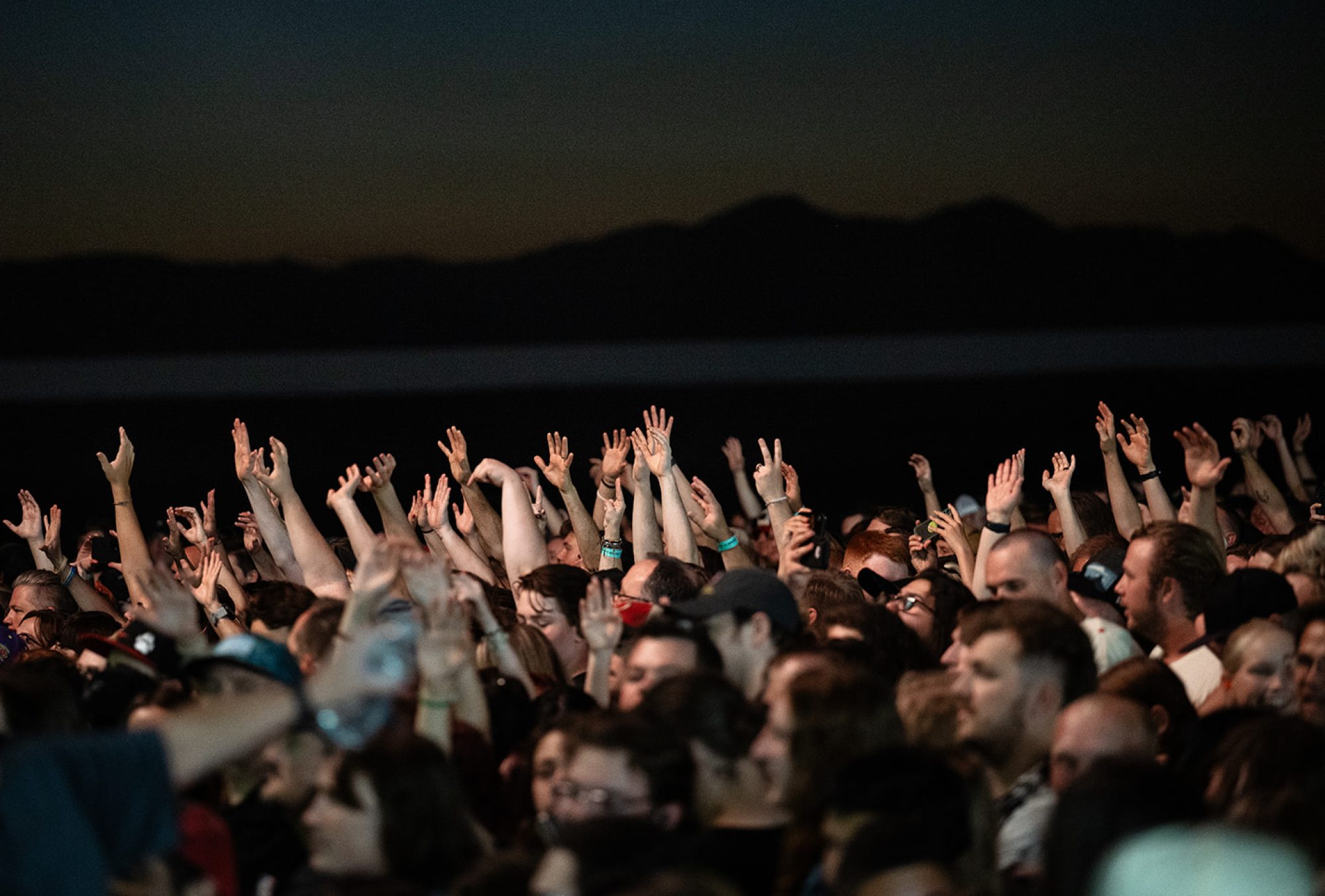By: Katie Barber

The crowd was forced to part as a casket was brought into the room. Its pallbearers strained under the weight before laying it down next to Kilby Court’s stage. The wildly unexpected sound of an industrial saw ripped through idle chatter—something was breaking free from within the casket. Emerged a figure with dark hair, a blue bandana around his neck, and a face painted ghostly white. Branson Anderson was back from the dead.

Anderson’s macabre entrance juxtaposed the scene that greeted concertgoers when they entered Kilby Court, which was much more reminiscent of a first grade classroom than a graveyard. A warm glow cast by a canopy of string lights illuminated the stage, and behind the band’s setup was a pair of apple trees that clung to the walls and extended overhead, complete with foliage and fruit. Also present were baskets of actual apples, free for the taking.
This whimsical world was built to celebrate the release of Anderson’s second album, Applecore, Baltimore, following up 2017’s Graydog. A self-proclaimed troubadour, Branson Anderson’s lyricism and instrumental aptitude have been compared to the likes of Bob Dylan and Johnny Cash. Such comparisons don’t seem too far off, as his first album is delivered in a way that works to uniquely transport listeners to the same lonesome towns and oblige them to feel the same love and loss about which he writes.

Immersed in this whimsy, Anderson was surely daring the audience to mistake him for another hopeless romantic. After rising from the casket, he announced he was indeed back from the dead, guided by a brash clash of drums and a steady bassline that shook the walls indicating rock ‘n roll had hitched a ride alongside him in that casket. An electric guitar made its way into Anderson’s hands and away the group went with “Wild Woman,” a track from his first album. Not a soul stood motionless and some sort of measured insanity—what you might expect after someone had just sawed themselves out of a casket—gripped the venue.
The pace of the set slowed slightly with “Don’t Go to the City,” and picked up with a faster rendition of “Moonshade,” both found on Applecore, Baltimore. Anderson’s guitar skills and crooning were excellently accompanied by the talents of drummer Tanner Williams and bassist Jake Martinez, who riffed to effortlessly transition between songs. “Here’s a little something from the first record. I think you’re going to like it,” announced Anderson during one such moment. The trio then played “Saltydog,” nearly unrecognizable with moments of screeching and a pace so much faster than its original version that blinking might have caused one to miss it.
As Anderson and his band covered tracks old and new, any doubts that this was a rock and roll show were lost. The air was crisp outside, but the room heated up as whistles, whoops, and screams from the audience accented Anderson’s own animalistic hoots and howls. It was clear that he was feeding off the energy of the room, at times getting so into the performance his vocals were delivered away from the mic, but shouted so loudly that they carried over the drum and bass.

“Moving on to the solo acoustic portion of the show,” Williams and Martinez left the stage and Anderson proceeded to perform the freshly debuted “Daddy’s Gonna Ramble” and “The Wrong Man.” As the set continued, it became ever-more evident that Anderson’s following had shown up in full force, with everyone in the room responding to his lyrics and clapping along to the beat during tracks such as “Tall” and “When I Go.” The audience interaction continued with friendly heckling, to which Anderson was quick to reply, and the space silenced as he left the stage and stood on top of the very casket he arrived in for “Dessert”—a poignant moment of symbolism that highlighted the intimacy of his music and its relationship to the dramatics of the night. After his final song, the attendees began to chant for at least one more, and the trio returned to accommodate the request.

What happened next was no encore—it was a performance that bookended the set by defying the notion of death once again with a whole lot of life, chewing up expectations and spitting them right back out. Channeling the energy of The White Stripes, adopting an attitude like HEAVY META-era Ron Gallo, and infusing an irresistible rhythmic foundation similar to Franz Ferdinand’s “Take Me Out,” the group delivered a ten-minute-long blues-rock finale that peeled the paint off Kilby Court’s walls. Somewhere among the wild jumping, crashing of cymbals, and screaming, Anderson paused briefly to contribute some spoken word while Williams and Martinez kept the beat in the background, after which the twang of Anderson’s guitar revived. He played it like it owed him money, getting low to the ground and out into the crowd with a precise violence that undoubtedly reverberated east across the Mississippi and west across the basin and range.

Those fortunate enough to be at Kilby Court that night will likely have a difficult time convincing others it actually happened, for a show like this one is the kind that becomes the stuff of myth. The eccentricity of the experience combined with such authentic artistry may very likely form on the periphery of memories like some sort of strange dream. One thing can be known for sure: from sweet talking serenades fit for traversing desert plains to caustic social critiques suited for dark urban alleyways, Branson Anderson’s got it all—ripe for the picking.

You can read Utah Concert Review’s interview with Branson and watch the music video for “Don’t Go to the City” here.
